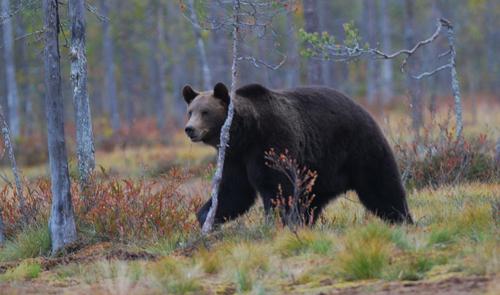Scientists confirm female Brown Bears have an active role, when it comes to choosing a partner.

The majority of studies of mammal reproduction attributes the males with a more active role during the mating season. This focus has caused the analysis of female reproductive behaviour to focus primarily on post-copulation breeding. However, an international team, led by researchers from the National Museum of Natural Sciences (MNCN-CSIC), has centred its work on the analysis of the movements of the female Brown Bears, Ursus arctos, over 21 years in three different populations. During that period, they have verified that the females travel the most during the mating season, which confirms that they are more active when it comes to mating than was previously believed.
The search for a mate makes the distribution areas of the females larger during the mating season
“As is the case with male bears, the female cover large areas of distribution, during the period in which they are looking to partner up, which is between the start of spring and summer. In fact, our data confirms that during the mating season, the females cover much larger distances”, stated the MNCN researcher, Vincenzo Penteriani. The study, published in the magazine Movement Ecology, provides sufficient evidence to yield these results given that results have developed similarly in the populations of Finland, Slovakia, and Romania. "The females of Finland have moved more during the mating season than in the populations of Romania or Slovakia, even greater movements are recorded during the period of hyperphagia, i.e. when they are increasing their food reserves in preparation for hibernation. Unlike in Slovakia and Romania, in Finland there are artificial food sources, so females may need to move less to get enough food. "These differences confirm to us that local environments also influence the movement and behaviour of the examples" clarified Penteriani.
A strategy to avoid infanticide
There are many factors that could inform the female bears decision to move during the mating period. On one side, it could be a good measure to reduce infanticide rates “One of the factors that increases the mortality of the bear cubsis that some males, when they detect the presence of female bears with cubs, kill them, so that the female will be ready to mate again. This does not occurr if the cubs are their own offspring, for this reason we think that the females mate with many males in different areas, to assure that their cubs will not be attacked later”, explained the researcher from the Mixed Institute of Biodiversity Research (IMIB), María del Mar Delgado.
They propose to analyse the reproductive patterns of female mammals by challenging the usual male-centred approach
“We have gathered date for over 21 years in three distinct geographical areas of Europe and we need to continue investigating how social and environmental conditions play a factor, as well as determining the evolutionary consequences that this sexual behaviour may have in female mammals. Because a more active role can be an important selective pressure in the evolution of mammalian reproductive strategies,” Penteriani concludes.
Date
Tuesday, 08 April 2025Publicado en
Movement EcologyInvestigador
Vincenzo PenterianiReferencias
V. Penteriani, M.M. Delgado, I. Kojola, S. Heikkinen, A. Fedorca, P. García-Sánchez, M. Fedorca, S. Find’o, M. Skuban, J. Balbontín, A. Zarzo-Arias, D. Falcinelli, A. Ordiz, J.E. Swenson. (2025) Mating from a female perspective: Do brown bear females play an active role in mate searching? Movement Ecology. DOI: 10.1186/s40462-025-00553-6.








